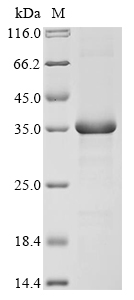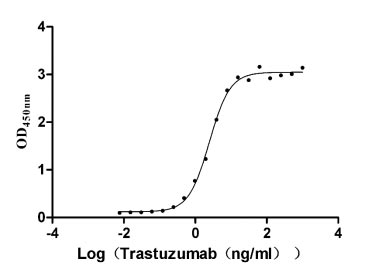Recombinant Human Syntaxin-17 (STX17)
-
货号:CSB-CF022892HU
-
规格:¥9720
-
图片:
-
其他:
产品详情
-
纯度:Greater than 85% as determined by SDS-PAGE.
-
基因名:
-
Uniprot No.:
-
种属:Homo sapiens (Human)
-
蛋白长度:Full Length of Mature Protein
-
来源:in vitro E.coli expression system
-
分子量:34.8 kDa
-
表达区域:2-302aa
-
氨基酸序列SEDEEKVKLRRLEPAIQKFIKIVIPTDLERLRKHQINIEKYQRCRIWDKLHEEHINAGRTVQQLRSNIREIEKLCLKVRKDDLVLLKRMIDPVKEEASAATAEFLQLHLESVEELKKQFNDEETLLQPPLTRSMTVGGAFHTTEAEASSQSLTQIYALPEIPQDQNAAESWETLEADLIELSQLVTDFSLLVNSQQEKIDSIADHVNSAAVNVEEGTKNLGKAAKYKLAALPVAGALIGGMVGGPIGLLAGFKVAGIAAALGGGVLGFTGGKLIQRKKQKMMEKLTSSCPDLPSQTDKKCS
Note: The complete sequence including tag sequence, target protein sequence and linker sequence could be provided upon request. -
蛋白标签:N-terminal 10xHis-tagged
-
产品提供形式:Liquid or Lyophilized powder
Note: We will preferentially ship the format that we have in stock, however, if you have any special requirement for the format, please remark your requirement when placing the order, we will prepare according to your demand. -
缓冲液:If the delivery form is liquid, the default storage buffer is Tris/PBS-based buffer, 5%-50% glycerol. If the delivery form is lyophilized powder, the buffer before lyophilization is Tris/PBS-based buffer, 6% Trehalose.
-
复溶:We recommend that this vial be briefly centrifuged prior to opening to bring the contents to the bottom. Please reconstitute protein in deionized sterile water to a concentration of 0.1-1.0 mg/mL.We recommend to add 5-50% of glycerol (final concentration) and aliquot for long-term storage at -20℃/-80℃. Our default final concentration of glycerol is 50%. Customers could use it as reference.
-
储存条件:Store at -20°C/-80°C upon receipt, aliquoting is necessary for mutiple use. Avoid repeated freeze-thaw cycles.
-
保质期:The shelf life is related to many factors, storage state, buffer ingredients, storage temperature and the stability of the protein itself.
Generally, the shelf life of liquid form is 6 months at -20°C/-80°C. The shelf life of lyophilized form is 12 months at -20°C/-80°C. -
货期:Delivery time may differ from different purchasing way or location, please kindly consult your local distributors for specific delivery time.
-
注意事项:Repeated freezing and thawing is not recommended. Store working aliquots at 4°C for up to one week.
-
Datasheet & COA:Please contact us to get it.
相关产品
靶点详情
-
功能:SNAREs, soluble N-ethylmaleimide-sensitive factor-attachment protein receptors, are essential proteins for fusion of cellular membranes. SNAREs localized on opposing membranes assemble to form a trans-SNARE complex, an extended, parallel four alpha-helical bundle that drives membrane fusion. STX17 is a SNARE of the autophagosome involved in autophagy through the direct control of autophagosome membrane fusion with the lysosome membrane. May also play a role in the early secretory pathway where it may maintain the architecture of the endoplasmic reticulum-Golgi intermediate compartment/ERGIC and Golgi and/or regulate transport between the endoplasmic reticulum, the ERGIC and the Golgi.
-
基因功能参考文献:
- MALAT1 modulates the autophagy of retinoblastoma cell through miR-124-mediated stx17 regulation. PMID: 29073720
- L. pneumophila Lpg1137 can shut down ER-mitochondria communication through cleavage of syntaxin 17 PMID: 28504273
- STX17 is targeted specifically to LC3 positive autophagosome membranes. STX17 interacts with LC3 and GABARAP and has binding sites for LC3 at aa 172-175 (LC3-Interaction Region 1 [LIR1]) and aa 189-192 (LIR2). PMID: 29420192
- SNARE priming, as exemplified by Syntaxin-17, is essential for maturation of autophagosomes but not for their formation. PMID: 29138318
- Data suggest that accumulation of autophagosomes confers cytotoxicity in a number of cell types including neurons mimicking neurodegeneration; RNA interference of combinations of MTOR, VPS33A, and STX17 lead to accumulation of autophagosomes and cytotoxicity. (MTOR = mechanistic target of rapamycin kinase; VPS33A = vacuolar protein sorting 33A; STX17 = syntaxin 17) PMID: 28673965
- Pacer recruits PI3KC3 and HOPS complexes to the autophagosome for their site-specific activation by anchoring to the autophagosomal SNARE Stx17. PMID: 28306502
- This study demonstrates that the amount of syntaxin 17 decreased in Hepatitis C Virus replicating cells. In addition, syntaxin 17 is identified to be a novel factor controlling the release of HCV, and the relevance of autophagosome-lysosome fusion as a regulator of the amount of released viral particles is revealed. PMID: 27099307
- Syn17 acts as a switch that responds to nutrient conditions and integrates functions for the endoplasmic reticulum and autophagosomes with mitochondrial dynamics PMID: 25619926
- the homotypic fusion and protein sorting-tethering complex promotes autophagosome-lysosome fusion through interaction with STX17 PMID: 24554770
- Study identifies syntaxin 17 (Stx17) as the autophagosomal SNARE required for fusion with the endosome/lysosome. PMID: 23217709
- The syntaxin 17 is essential for maintaining the architecture of ERGIC and Golgi. PMID: 21545355
- Common variants in the STX17 gene region do not play a key role in the pathogenesis of human melanoma. PMID: 19209086
显示更多
收起更多
-
亚细胞定位:Endoplasmic reticulum membrane; Multi-pass membrane protein. Smooth endoplasmic reticulum membrane; Multi-pass membrane protein. Endoplasmic reticulum-Golgi intermediate compartment membrane; Multi-pass membrane protein. Cytoplasmic vesicle, autophagosome membrane; Multi-pass membrane protein. Cytoplasmic vesicle, COPII-coated vesicle membrane; Multi-pass membrane protein. Cytoplasm, cytosol.
-
蛋白家族:Syntaxin family
-
数据库链接:
HGNC: 11432
OMIM: 604204
KEGG: hsa:55014
STRING: 9606.ENSP00000259400
UniGene: Hs.704031
Most popular with customers
-
Recombinant Human Receptor tyrosine-protein kinase erbB-2 (ERBB2), partial (Active)
Express system: Mammalian cell
Species: Homo sapiens (Human)
-
Recombinant Human Angiopoietin-2 (ANGPT2) (Active)
Express system: Mammalian cell
Species: Homo sapiens (Human)
-
Recombinant Human Oncostatin-M (OSM), partial (Active)
Express system: Mammalian cell
Species: Homo sapiens (Human)
-
Recombinant Human Carcinoembryonic antigen-related cell adhesion molecule 8(CEACAM8) (Active)
Express system: Mammalian cell
Species: Homo sapiens (Human)




-AC1.jpg)












